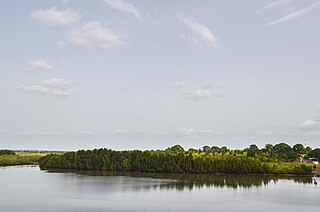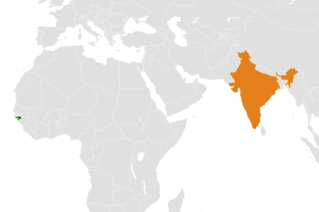
Guinea is a country on the coast of West Africa and is bordered by Guinea-Bissau, Senegal, Mali, Ivory Coast, Liberia, and Sierra Leone.
Guinea-Bissau was dominated by Portugal from the 1450s to the 1970s; since independence, the country has been primarily controlled by a single-party system.

This article describes the geography of Guinea-Bissau.

Guinea-Bissau is among the world's least developed nations and one of the 10 poorest countries in the world, and depends mainly on agriculture and fishing. Cashew crops have increased remarkably in recent years, and the country now ranks sixth in cashew production.

Bissau is the capital city of the African Republic of Guinea-Bissau. In 2015, Bissau had a population of 492,004. Bissau is located on the Geba River estuary, off the Atlantic Ocean, and is Guinea-Bissau's largest city, major port, and its administrative and military centre.

Gabú region is the eastern-most region in Guinea-Bissau. Its capital is Gabú. The region borders Senegal to the north, Guinea to the east and south and the Guinea-Bissau regions of Tombali and Bafatá to the west. It covers an area of 9,150 km2, making it the largest of Guinea-Bissau's administrative regions. It is an inland region covered with Savannah or light Savannah woodland and receives an annual rainfall of more than 2,000 mm (79 in).

Oio is a region in Guinea-Bissau. Its capital is Farim. Other major cities and towns include Nhacra, Mansôa, Bissorã and Cumeré. The region borders Senegal to the north, the Guinea-Bissau regions of Bafatá, Bissau and Biombo to the east, the Rio Geba/Guinea-Bissau region of Quinara to the south and the Guinea-Bissau region of Cacheu to the west. There has not been any local administration since the civil war of 1998-99 and all the social services are done by organs of civil society and other government agencies. It is a coastal region covered with Mangrove swamps, rain forest and tangled forest and receives an annual rainfall of more than 1,000 mm (39 in), while the inland has Savannah woodlands.

The Guinea-Bissau War of Independence was an armed independence conflict that took place in Portuguese Guinea between 1963 and 1974. Fought between Portugal and the African Party for the Independence of Guinea and Cape Verde, an armed independence movement backed by Cuba and the Soviet Union, the war is commonly referred to as "Portugal's Vietnam" due to the large numbers of men and amounts of material expended in a long, mostly guerrilla war and the internal political turmoil it created in Portugal. The war ended when Portugal, after the Carnation Revolution of 1974, granted independence to Guinea-Bissau, followed by Cape Verde a year later.

Cacheu is a region in western Guinea-Bissau, on the border with Senegal. It has an area of 5,175 km2 and a population estimated in 2004 at 164,676. Its capital is Cacheu. There has not been any local administration since the civil war of 1998-99 and all the social services are done by organs of civil society and other government agencies. It is a coastal region covered with Mangrove swamps, rain forest and tangled forest and receives an annual rainfall of more than 1,000 mm (39 in)

Biombo is a region in western Guinea-Bissau, with an area of 840 km2 and its capital is Quinhámel. There has not been any local administration since the civil war of 1998-99 and all the social services are done by organs of civil society and other government agencies. It is a coastal region covered with Mangrove swamps, rain forest and tangled forest and receives an annual rainfall of more than 1,000 mm (39 in).

Bafatá is a region in north-central Guinea-Bissau and its capital is Bafatá. It is an inland region covered with Savannah or light Savannah woodland and receives an annual rainfall of more than 2,000 mm (79 in).
The Taça Nacional da Guiné Bissau is the top knockout tournament of the Guinea-Bissauan football. It was created in 1976. Some of the competition, the semis and the finals are broadcast on radio (RGB) first aired after independence in 1974 and national television, TGB, the television station was mostly been the only network of the nation up to around 2010.

Guinea-Bissau made its Paralympic Games debut by sending a delegation to compete at the 2012 Summer Paralympics in London, United Kingdom, having made its Olympic debut at 1996 Games. The delegation consisted of two athletes, Cesar Lopes Cardoso and Ussumane Cande, who both competed in track and field events. Neither athlete won a medal, with neither getting past the first round of their events.
Francisco Santos da Silva Júnior, commonly known as Francisco Júnior, is a Bissau-Guinean professional footballer who plays as a midfielder for Danish Superligaen club Vendsyssel and the Guinea-Bissau national football team. He has also represented Portugal internationally at under-19 and under-21 level.

Guinea-Bissau competed at the 2016 Summer Olympics in Rio de Janeiro, from August 5 to 21, 2016. This was the nation's sixth consecutive appearance at the Summer Olympics.
Edouard Mendy is a footballer who plays as a goalkeeper for Stade de Reims. Born in France, Mendy represents the Senegal national football team.

Guinea-Bissau–India relations refers to the international relations that exist between Guinea-Bissau and India. The Embassy of India in Dakar, Senegal is concurrently accredited to Guinea-Bissau. India opened an Honorary Consulate in Bissau on 28 May 2010. Guinea-Bissau has no diplomatic mission in India.
Media of Guinea-Bissau includes print, radio, television, and the Internet. "The Conselho Nacional de Comunicação Social regulates the press." The government-run Radio Televisao de Guinea-Bissau began in 1973.
The 2016–17 Campeonato Nacional da Guiné-Bissau season is the top level of football competition in Guinea-Bissau. It began on 10 September 2016 and concluded on 21 May 2017.












